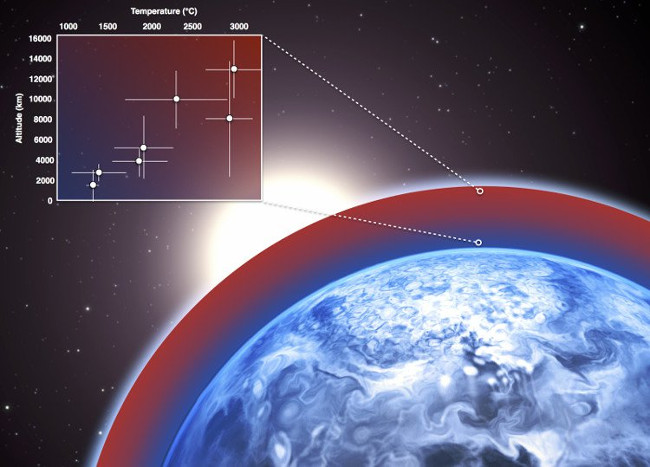Discover the strange green planet HD 189733b outside the solar system
The study of Swiss astronomers points to extraterrestrial HD 189733b with the most extreme weather in the universe: wind speed of 8,700 km / h and atmosphere of 3,000 degrees C.
Exotic planet HD 189733b is a " beautiful green dot " planet in an ink-black sea, like Earth. But that is just the similarity between the two planets in the last position.
 Discover the strange green planet HD 189733b outside the solar system Picture 1 HD 189733b extraterrestrial images are about the size of Jupiter. Scientists say: "The blue of extraterrestrial HD 189733b may be due to light scattering silicate particles in the atmosphere ". (Image source: ESO / M. Kornmesser)
Discover the strange green planet HD 189733b outside the solar system Picture 1 HD 189733b extraterrestrial images are about the size of Jupiter. Scientists say: "The blue of extraterrestrial HD 189733b may be due to light scattering silicate particles in the atmosphere ". (Image source: ESO / M. Kornmesser)
First, extraterrestrial HD 189733b is much bigger and hotter than the planet Earth, about the same size as Jupiter and revolving around its host star with orbit of 2.2 Earth days. That trajectory is so close that this outer planet may be exposed to a " lock tide ", displaying one side of its star, much like the Moon often shows one side (close side) to the Earth.
 Discover the strange green planet HD 189733b outside the solar system Picture 2 Planetary atmosphere HD 189733b has a temperature of up to 3,000 degrees C. (Photo source: NASA / ESA)
Discover the strange green planet HD 189733b outside the solar system Picture 2 Planetary atmosphere HD 189733b has a temperature of up to 3,000 degrees C. (Photo source: NASA / ESA)
Next is the weather . The winds on the planet outside the solar system HD 189733b (located about 63 light-years from Earth, in the constellation Vulpecula) clocked up to 8,700 km / h - 7 times the speed of sound. However, if this condition is not severe enough, scientists added that the rain on this planet is not water but a glass of rain like " thousands of deadly cuts ".
" Why does this bizarre planet appear close to Earth? It's just a coincidence ," the scientists said.
The planet's blue color is not a reflection of the ocean as it is on Earth but because of the planetary atmosphere, which consists of clouds interspersed with sillicat particles.
"The green color of this planet is not a reflection of the tropical ocean, like Earth, but because of a misty atmosphere, blowing gas that includes clouds mixed with silicate particles ," officials said. by the US Aeronautics Agency (NASA) wrote in a statement.
There may also be many blue-free ocean planets outside the alien planet HD 189733b. In fact, scientists have found two exoplanets in the Earth's solar system: Uranus and Neptune . The high atmosphere of both " giant ice planets " contains methane, which affects the blue wavelength of light returning to the Sun in space.
Planetary HD 189733b was discovered in 2005 and scientists have determined its color in 2013 using NASA's Hubble Space Telescope and other tools. Alien Planet HD 189733b is one of the six brightest planets in NASA's " Galaxy of Horrors" - a special Halloween collection collected by the US Aerospace Agency this year. You can see the collection "Galaxy of Horrors" here.
You should read it
- Successfully measuring weather systems on planets outside the solar system
- NASA discovered water in planetary Neptune's atmosphere
- 7 alien planet is more exotic than science fiction movies
- NASA declares the existence of the 9th planet in our Solar System
- Interesting discovery of strange planets outside the solar system
- NASA announced concussion: 7 Earth-sized planets could have life
- Space Science: The order of 8 (or 9) planets in the Solar System
- The interesting fact about the universe is not quite the same as what we thought
- How big is the solar system?
- NASA's space telescope finds three new planets with rare features
- Discovering a new planet with all the conditions to make a new place for humanity
- Detects a hot alien planet, about the same size as the Earth
May be interested

The biggest super moon in 70 years will appear on November 14

Top 10 interesting facts about the Moon you may not know

20 pictures of super beautiful splendor around the world on November 14

'Aliens will arrive on Earth in September 2017' - Nostradamus' prediction

How hot is the planet of Mercury?

Reveal the best place to find life on Mars






 Successfully measuring weather systems on planets outside the solar system
Successfully measuring weather systems on planets outside the solar system When can we determine the position of the '9th planet' in the solar system?
When can we determine the position of the '9th planet' in the solar system? NASA declares the existence of the 9th planet in our Solar System
NASA declares the existence of the 9th planet in our Solar System The deviating object in the Kuiper Belt may be the 10th planet of the solar system
The deviating object in the Kuiper Belt may be the 10th planet of the solar system Discover a new dwarf planet about the size of a Pluto in the Solar System
Discover a new dwarf planet about the size of a Pluto in the Solar System Photos of the 9th planet in our solar system
Photos of the 9th planet in our solar system